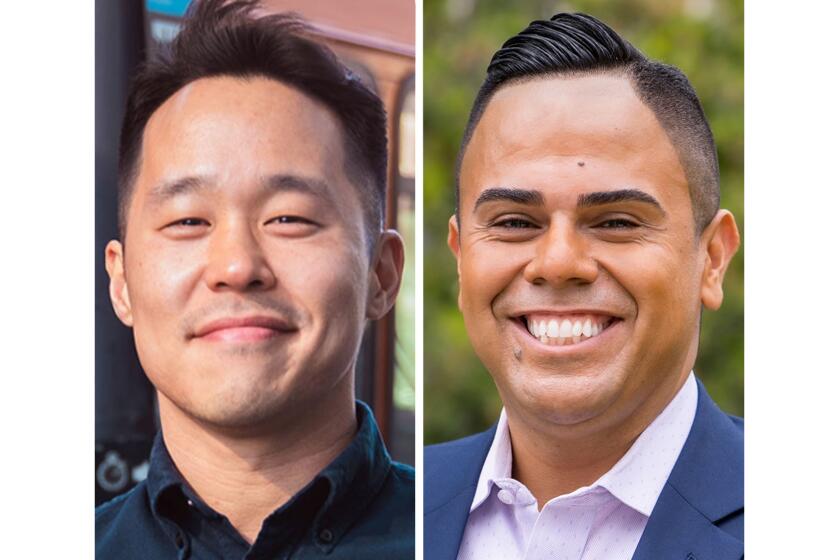The Region : THE WEEK : Splitting the state down the middle
Last week’s Los Angeles Times/USC poll spilled a flood of pessimism from California voters about their state: They’re troubled by its direction, upset at its politicians and sure that nothing will wrest California from the abyss.
That was about it, when it came to agreement. One always presumes a fair amount of communal thought in a state, even one this large. But apart from a shared disdain for the governor and the Legislature, there is hardly anything communal anymore in California politics.
Political strategists these days do what is called “micro-targeting,” directing their appeals to ever smaller slices of people; gone are the days when a singular argument could win over the masses. That, it turns out, is a pretty reasonable response to what is happening on the ground.
Under the surface, the California vote is factionalized between the liberal-leaning Bay Area and Los Angeles denizens, the moderate suburbanites who surround them and the wielders of the conservative flame -- the conservatives of the Central Valley.
There, only 7% of voters felt the state was on the right track -- half the percentage found statewide. There, conservative stalwart Chuck DeVore was leading his rich competitor, businesswoman Carly Fiorina, in the race for the Republican Senate nomination, even if few others statewide had heard of him.
As the state becomes more and more diversified, its enclaves are hardening their views.
“There are dozens of different Californias -- hundreds, demographically -- and every single one of those Californias thinks the rest of them are wrong about everything,” said Dan Schnur, head of the Jesse M. Unruh Institute of Politics at USC, whose College of Letters, Arts and Sciences co-sponsored the poll with The Times.
The firmest of the present splits, however, is the east-west divide. There is a yawning gulf between the left-leaning coastal regions that feed California’s stereotype and the right-leaning inland areas that seem firmly planted in Middle America rather than the land of the Beach Boys.
Demographically, the poll demonstrated, the two populations are distinct.
Inland voters are far more likely to be religious. Almost half were Protestant -- a reflection of the strong evangelical movement -- though that was true of only three in 10 coastal voters. Church attendance, which political analysts see as a key indicator of political behavior -- the more often one attends services, the more reliably conservative the vote -- was also different. In inland areas, almost four in 10 voters said they went to services at least once a week, while three in 10 coastal voters made that claim.
Inland voters were older, more conservative and more likely to be married and white than coastal voters. Interestingly, location seemed at times to trump race or gender. Latino voters who live in the area espoused more conservative views than their coastal brethren. Two-thirds of coastal Latinos were registered Democrats; fewer than half of inland Latinos were. One third of coastal Latinos described themselves as “liberal,” twice the proportion of inland Latinos.
Although the state is reliably Democratic at the moment, California’s growth is now largely coming from the inland areas and from the Central Valley in particular, making the area noteworthy for the long term. According to a Field Poll report on California voters, 55% hailed from Los Angeles or the Bay Area in 1978. Now, 46% do. Almost three in 10 voters now reside inland, on a path winding north from the Inland Empire through the state’s agricultural fields.
The conservative tendencies inland are colliding, however, with the urban problems bedeviling their residents. Air quality and health issues are profound, and shortcomings involving education and the economy have come into sharp relief during the recession.
California’s inland counties have unemployment rates far higher than the state overall. In September, both Fresno and Kern counties hovered near 14%; Los Angeles, in contrast, was at 12.7% and San Francisco was below 10%.
As troubling to Central Valley analysts are education statistics. The region’s teenagers are more likely than Californians overall to drop out of high school and less likely to head to a UC school or other four-year college.
“This is a recipe for disaster,” said David Hosley, president of the Great Valley Center, a nonprofit think tank that studies Central Valley issues. If it’s not altered swiftly, he said, “we will be in a downward spiral that will be hard to turn around.”
Ironically, the solution for economic recovery could weaken the region’s conservative moorings, at least somewhat. Until recently, when UC Merced opened and offered another local option for educational pursuit, many younger ambitious residents had to leave in order to achieve.
Carol Whiteside, the former mayor of Modesto who founded the Great Valley Center in 1997, somewhat wincingly calls her home turf “everybody’s branch office” because few corporations are headquartered there.
“What that means is oftentimes the people most well educated have to leave the region to find the jobs and opportunities they seek -- and that robs the region of leadership and intellectual strength,” she said.
If that changes, some expect moderation in the area’s political views. The low college attendance rate “is probably what keeps the attitudes and the values of the Central Valley so conservative,” Hosley said. “We know that when people go off to college, they not only learn things but they see things in a broader way.”
--
Each Sunday, The Week examines implications of major stories. It is archived at latimes.com/theweek.
More to Read
Get the L.A. Times Politics newsletter
Deeply reported insights into legislation, politics and policy from Sacramento, Washington and beyond. In your inbox three times per week.
You may occasionally receive promotional content from the Los Angeles Times.











